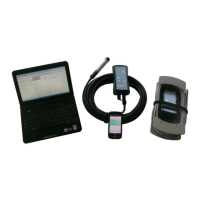Sommer GmbH 11
Input form:
The tracer injection has to be carried out in dissolved form.
Input quantity:
The input quantity depends on the total discharge, the base value and the mixing distance.
The more tracer substance is injected, the greater the maximum deflection of the measured values.
The goal is to achieve a maximum deflection of at least 200 µS/cm respectively 100% of the base value
(see above diagram).
The rule of thumb to approximate the amount of tracer substance needed is 5 kg per m³/s of total
discharge. In case the resulting measurement curve shows that the maximum deflection is well below the
aforementioned minimum increase the measurement can be easily repeated with a higher amount of
tracer substance. In such a case the previous measurement result can be used to more accurately
estimate the total discharge of the river.
If the measured values exceed the probe’s detection limit of 5000 µS/cm the measurement result is
invalid. In such a case the measurement should be repeated with i.e. half the amount of tracer used in the
first attempt.
Ad 2: Selection of the mixing distance
The goal is a complete vertical and lateral distribution of the tracer substance at the measurement
location.
Rule of thumb: Mixing distance = 50-times the width of the water body to be measured (for low
turbulences)
Attention: The longer the mixing distance the better the mixing, but at the same
time the lower the maximum deflection and the longer it takes for the
complete tracer to pass the measurement location (this can be
compensated for by using a higher amount of tracer substance, i.e. > 5
kg per m³/s).
A shorter mixing distance (reduced down to 20-times the width of the water body) can be chosen
when the following preconditions are fulfilled:
o High turbulences
o Changing cross sections
o High roughness
o Presence of stones and rocks
Ad 3: Positioning of the probes
The goals are:
o Good circulation of water around the probes
o Stable position of the probes
o Probes have to lie on the bottom of the river bed in high turbulent flows or hang in the water in low
tortuous flows.

